The complete guide to SEO search intent
User intent is the reason behind a user’s search query. It refers to what the user is hoping to achieve by entering keywords into a search engine.
There are five common search intents: informational (seeking knowledge), navigational (targeting specific websites), transactional (aiming to purchase), commercial (researching products before buying), and local (focusing on nearby businesses or services).
Benefits of optimizing for user intent include but are not limited to higher search engine rankings, increased website traffic, improved conversion rates, and enhanced brand trust.
Determining user intent usually involves analyzing keyword modifiers and examining SERPs. Keyword modifiers reveal the goal behind a particular search, while SERP analysis shows what kind of content ranks for a specific keyword.
There are a number of tools that can help you determine the user intent behind keywords, including SE Ranking’s Keyword & Competitive Research tools.
Have you ever been impressed by how Google seems to know exactly what you’re looking for, even with a simple search term? That’s because Google’s gotten super smart. In the past, it relied on matching keywords. Now, it uses complex algorithms to figure out the underlying question behind keywords. That’s where search intent steps in.
By following the “one search intent = one page = one keyword cluster” rule, you can design content that caters to various search intent queries and make it easier for Google to rank your pages faster.
In this article, we’ll explain what search intent is, why it is important for SEO, how to determine search intent from keywords, and what the main benefits of search intent targeting are.
What is User Intent?
User intent (search/audience/keyword intent) is the term used to describe a person’s goal when entering a search phrase. For instance, they might be seeking information on a specific topic, a solution to a problem, or looking to make a purchase.
By understanding the purpose of an online search query, you can:
- Get more organic traffic as your page will be highly relevant for the search query.
- Get a more relevant target audience to your website.
- Build brand trust by using your content to show that you understand what users are looking for.
- Attract more qualified leads ready to make a conversion.
- Improve your keyword research strategy by focusing more on search queries that meet your audience’s needs.
- Produce valuable human-oriented content.
- Increase your SERP rankings, thereby getting more visibility, building credibility, and improving domain authority.
Understanding search intent is key to effective semantic SEO.
With SE Ranking’s Keyword Ranking Tracker, you can easily monitor your progress in optimizing content for search intent. The higher you rank, the better you understand and satisfy user needs.
Take a look at our guide on tracking search engine rankings to learn more effective techniques for analyzing your website’s performance on search engines and optimizing your content strategy.
The 5 Types of Search Intent
Now, let’s dive deeper into the main search intent categories.
- Informational: The goal is to acquire specific data, conduct research a particular topic, or learn new information.
- Commercial: The goal is to find more detailed information on a product/service before making a purchase.
- Transactional: The goal is to make a purchase.
- Navigational: The goal is to find a specific brand/website.
- Local: The goal is to find products/services available within a specific geographic area.
Expand your understanding of search intent and other essential SEO concepts by enrolling in our online Basic SEO Course.
Informational Search Intent
The goal behind informational searches is to learn something new. These search queries could be in the form of a specific question (e.g., how long does it take to become a doctor) or broad investigations that require research (e.g., the role of mass media in childhood socialization).
Google usually displays answers to specific questions with the help of featured snippets. These highlighted excerpts of text sit at the top of the SERP so users can save time browsing the Internet.
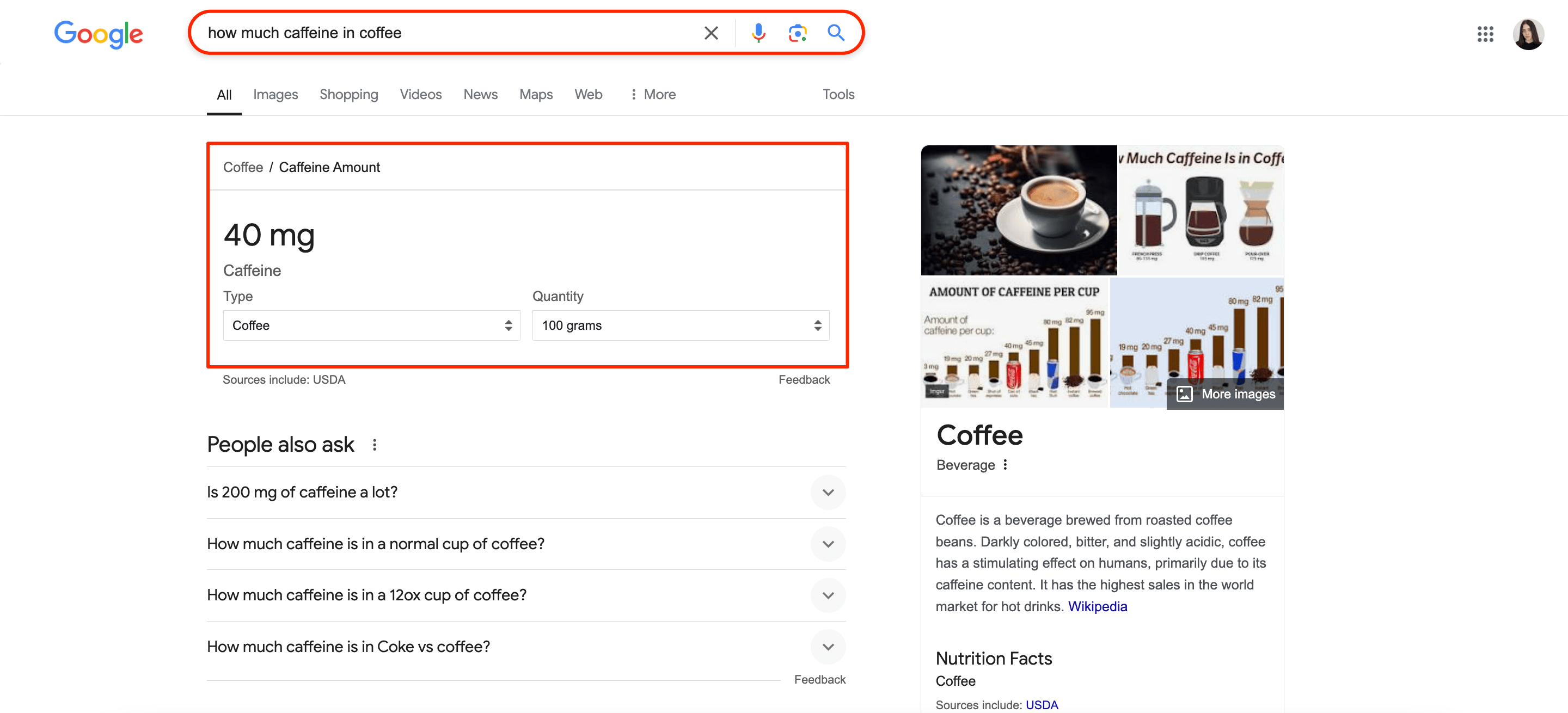
Informational SEO search intent can be recognized by question words like who, what, when, where, why, how, etc. For instance:
- Who invented the radio?
- When did the Titanic sink?
- Why doesn’t it thunderstorm in the winter?
But that’s not always the case. Google also infers informational search intent from general noun keywords, such as:
- Carbonara sauce
- Chetham’s Library location
- UX writing trends
How to Optimize for Informational User Intent
To get started, examine the way people look up information online. Discover informational queries around your topics with the help of these features:
- Google’s People Also Ask (PAA) section —type your keyword into the search box and find lots of related questions that people are searching on Google.
- Google’s Related Searches section —just like the PAA section, the Related Searches block provides related suggestions in the form of keywords.
- SE Ranking’s keyword search offers a list of similar, related, and low-search volume keywords for you to optimize your content for.
Just click Keyword Research in the top navigation bar, paste a seed keyword, and scroll down to the Keyword Ideas section.
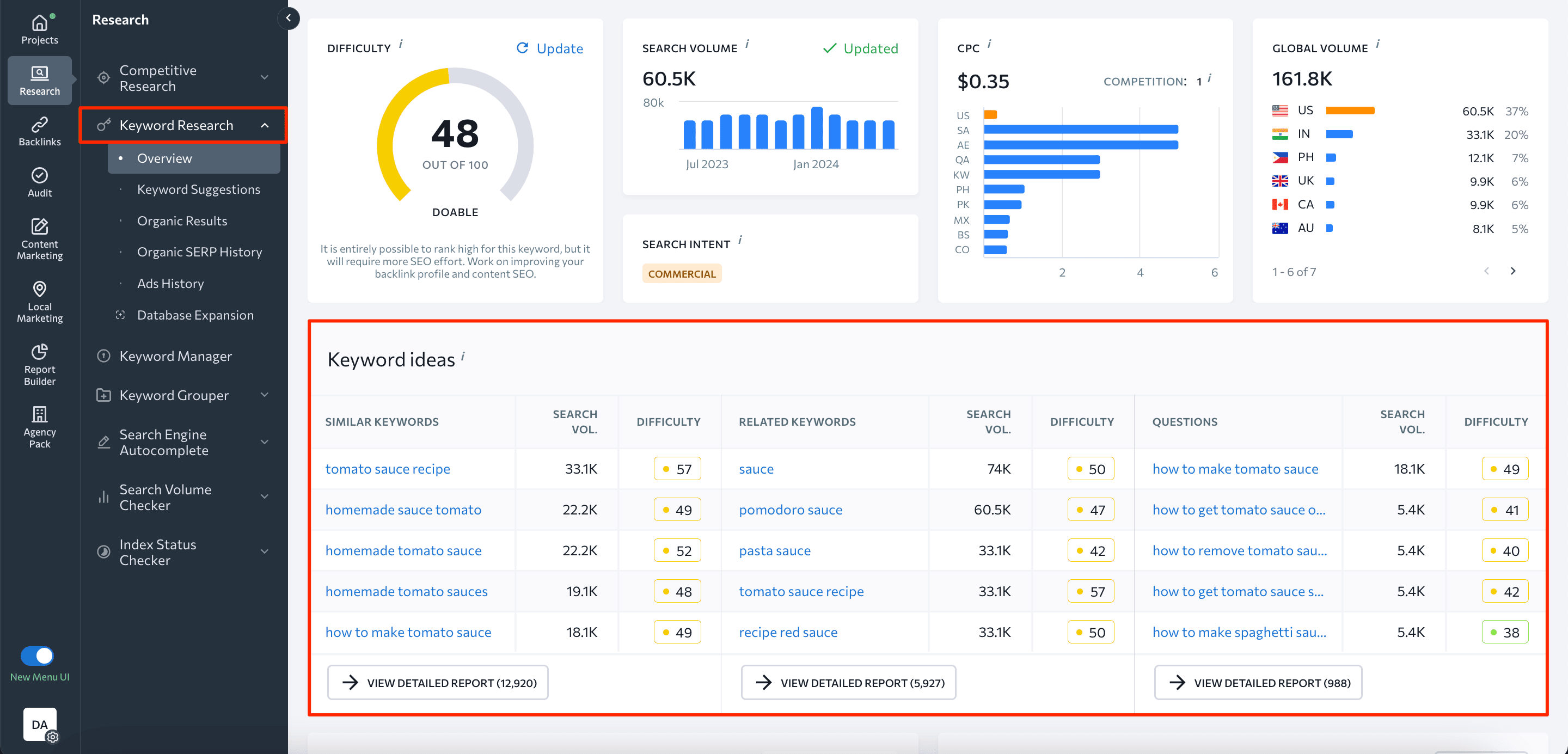
Alternatively, you can directly access this tool from the widget below:
By filtering these keywords with the help of question keywords, you can find a variety of valuable content ideas for your blog. To do this, go to the list of keywords, hit Filter, and add question words like how, where, why, when, etc. You’ll find plenty of topics that are interesting to your audience.
Then, create blog posts, in-depth guides, how-to videos, and checklists around these keywords, as these are the most popular forms of informational content on the Internet.
Navigational Search Intent
Users with navigational intent are looking for a specific web page or domain. These queries are typically used as an alternative for typing the entire URL into Google’s search bar. Here are some more examples of queries with navigational user intent:
- SE Ranking website audit
- Twitter sign up
- Google Analytics
Make sure your website can be easily found. When someone searches for your company’s name online, the audience should be able to access your platform with minimal effort.
It also makes sense to audit a website to identify and rectify any technical errors that may impact its accessibility. Indexing errors are among the most critical ones. If search engines can’t index your pages, although optimized for navigational intent, they won’t appear in the SEPR, and your customers won’t see them.
How to Optimize for Navigational User Intent
There’s not much you can do with the navigational search intent outside of your own domain. Users with this intention are typically looking for a specific link pointing out to the website. Your task is to do everything in your power to nab and hook the first position on the SERPs for all variations of your brand’s name.
But how do you do it? Create relevant content around navigational keywords, such as:
- Price
- Reviews
- Location
- Login
- Testimonials
Transactional Search Intent
Whether it be a product, service, or subscription, people with transactional search intent are looking for the right place to buy something. This is why transactional searches often include words like buy, subscribe, price, cheap, discount, sale, order, and so on. Here are examples of transactional search queries:
- Cheap tickets online
- Buy body cream
- Denim jackets sale
Still, transactional queries are not always this obvious. Sometimes people type the name of a product or service into Google’s search bar without any additional modifiers. A “denim jacket” query, for instance, most likely has transactional intent even though it’s not accompanied by other words, such as buy, sale, and so on.
How to Optimize for Transactional User Intent
To get the most out of transactional intent optimization, begin by auditing the following page types:
- Landing pages
- Product pages
- Pricing pages
- Sales pages
- Event pages
These are the most likely pages to appear in SERPs for transactional intent queries. They are also “responsible” for generating sales on your website.
To audit and improve keyword intent SEO on each page, you’ll need to analyze page SEO factors such as the title tag, meta description, heading tags, content, and internal linking. It’s important to ensure that each of these elements is optimized with the relevant keywords and intent in mind.
To learn more about on-page SEO —whether it’s one page per time or all pages in bulk—check out our complete guide on this topic.
Commercial Search Intent
Commercial intent is usually perceived as something lying in the middle of informational and transactional intent queries. Simply put, the user has already decided to buy something but still needs to conduct a commercial investigation to make the final decision.
Take a look at different examples of commercial intent queries:
- Android and IOS comparison
- Top hotels in Las Vegas
- MacBook Air vs Pro
How to Optimize for Commercial User Intent
Make sure to target commercial queries, be honest about a product’s shortcomings, and structure your content so that it clearly answers your audience’s questions.
For example, let’s take a look at the comparison table presented by Tesla:
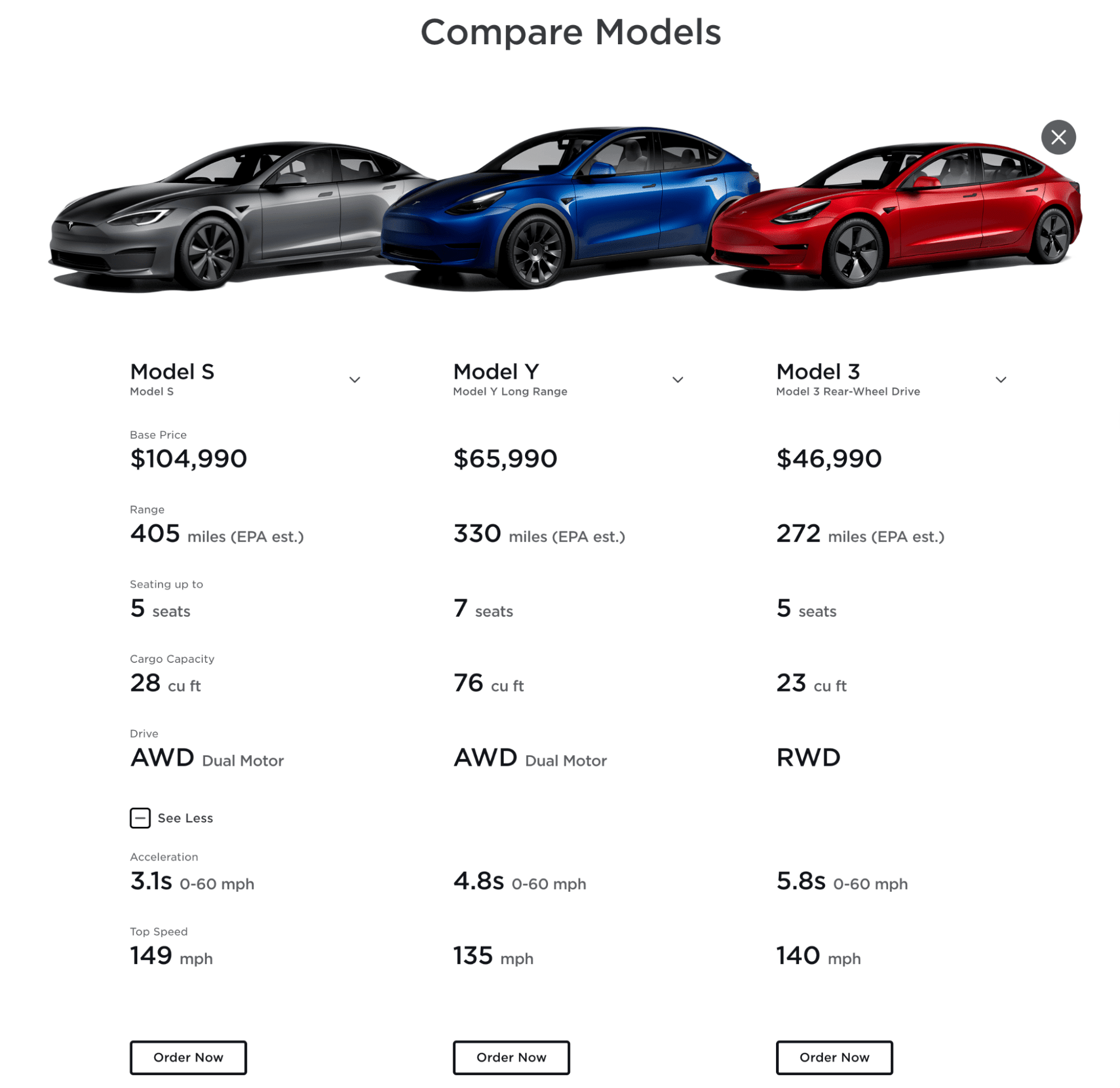
Despite minimal text, the webpage effectively compares three car models in a visually appealing format. Potential buyers can easily navigate and compare options before making a decision. Subtle call-to-action buttons encourage purchases without being overly pushy, contributing to the website’s conversion rate.
Local Search Intent
Local search intent refers to the search queries made by users with the intention of finding information, products, or services available in their local area. Often, users expect to see these places on Google Maps when inputting these kinds of queries. They also expect to see the direction from their current location.
Some examples of local search intent queries are:
- Restaurants near me
- Events this weekend in [city name]
- Pet stores near [zip code]
How to Optimize for Local User Intent
Here are some tips on how to optimize your website for local user intent:
- Create a Google Business Profile: By creating GBP, you can appear on Google Maps and local Google search results when users search for businesses like yours in your area. Also, make sure your NAP is consistent.
- Include local keywords in your website content: Including local keywords in your website’s content can help search engines understand that your business is relevant to local users.
- Optimize your website for mobile devices: Each year, more and more users perform local searches on their mobile devices. This is why it is essential to ensure that your website is mobile-friendly and loads quickly on mobile devices.
- Encourage customer reviews: Positive customer reviews can give an added boost to your business’s online visibility and reputation. Encourage your customers to leave reviews on your Google Business Profile listing, Yelp, or other review sites.
- Use dedicated software: Platforms like SE Ranking can help you significantly streamline your local SEO efforts. Its Local Marketing Module can help you track local search ranking, manage NAP consistency, monitor reviews, as well as identify existing issues in GBP and other business listings.
When multiple pages target similar intent using the same keywords, it can result in keyword cannibalization, where your own content competes in SERPs. Learn how to detect and fix it in our keyword cannibalization guide.
How to Determine Search Intent from Keywords
Determining keyword search intent is an integral part of any content marketing strategy. There are three main practices for identifying audience intent—and they don’t take much effort on your part.

Analyze Keyword Modifiers
By considering keyword modifiers, you can identify SEO user intent without using additional techniques.
- Informational keyword modifiers are who, what, when, where, why, how, etc.
- Navigational keyword modifiers are [brand name], [product name], [service name], etc.
- Transactional keyword modifiers are buy, subscribe, price, cheap, discount, sale, near me, order, etc.
- Commercial keyword modifiers are review, vs, best, top, alternative, comparison, and so on.
But identifying user intent is more complex than finding modifiers (especially for the transactional and commercial intent), so the best way is to check the SERP for your keywords of interest.
Examine the SERPs
Identify user intent by typing the target keyword phrase into the search bar and analyzing Google’s search results. This is the best way to figure out user intent because you’re essentially getting hints from Google’s algorithms as to what it believes is the best match for your searched keyword.
To get in-depth information on top SERP players and all their major metrics—and on a single screen, you can use SE Ranking’s SERP Analyzer tool. Choose the depth of analysis (we recommend choosing the top 5 and top 10 results when analyzing user search intent), select any country/region, and enter a keyword from which to find top-performing webpages.
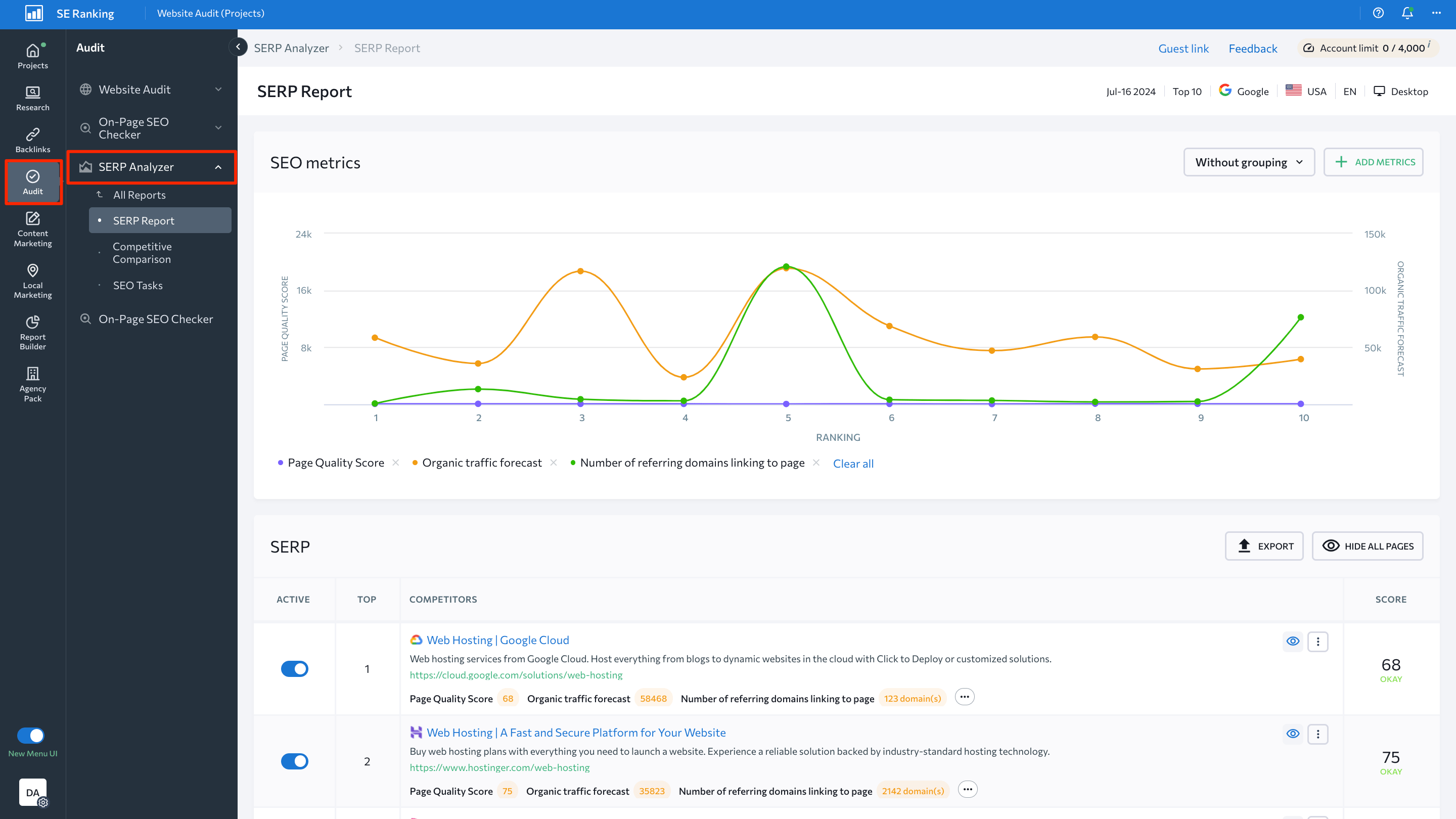
By using this tool, you can:
- Identify the main SERP players.
- Analyze their associated SEO metrics.
- Determine the main ranking factors for a certain SERP.
- Learn more about the type of content offered by top-performing pages and how optimized they are.
Since you will always see different types of SERPs depending on the intent of keywords, let’s go over the different types of intent in more detail.
SERP Results for Informational Intent
Most often, Google reacts to keywords with informational intent with Knowledge Panel, featured snippets, and People Also Ask sections. Wikipedia or informative articles oftentimes occupy the primary positions for these keywords. Also, the majority of URLs in the top 10 would include something like “blog,” “guide,” etc in their URLs. Take a look at this example:
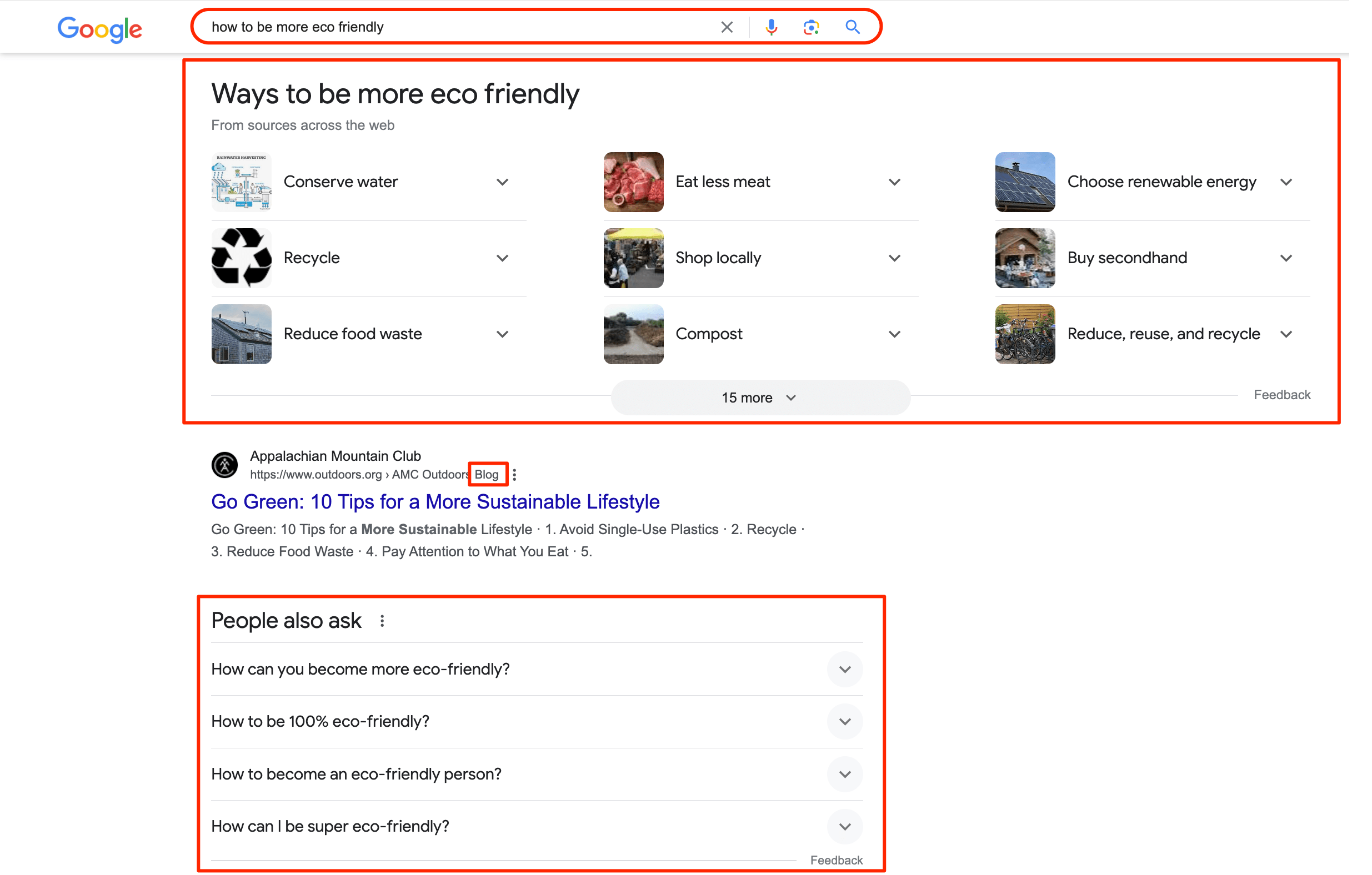
SERP Results for Navigational Intent
Considering that searchers with navigational intent already have the exact domain they’re looking for in mind, these results typically feature the most relevant page within that domain at the top of SERPs. You can also find additional site links and Knowledge panels in search results depending on the search you run.
The first organic result will most likely include the product or brand name in the URL, page title, and meta descriptions.
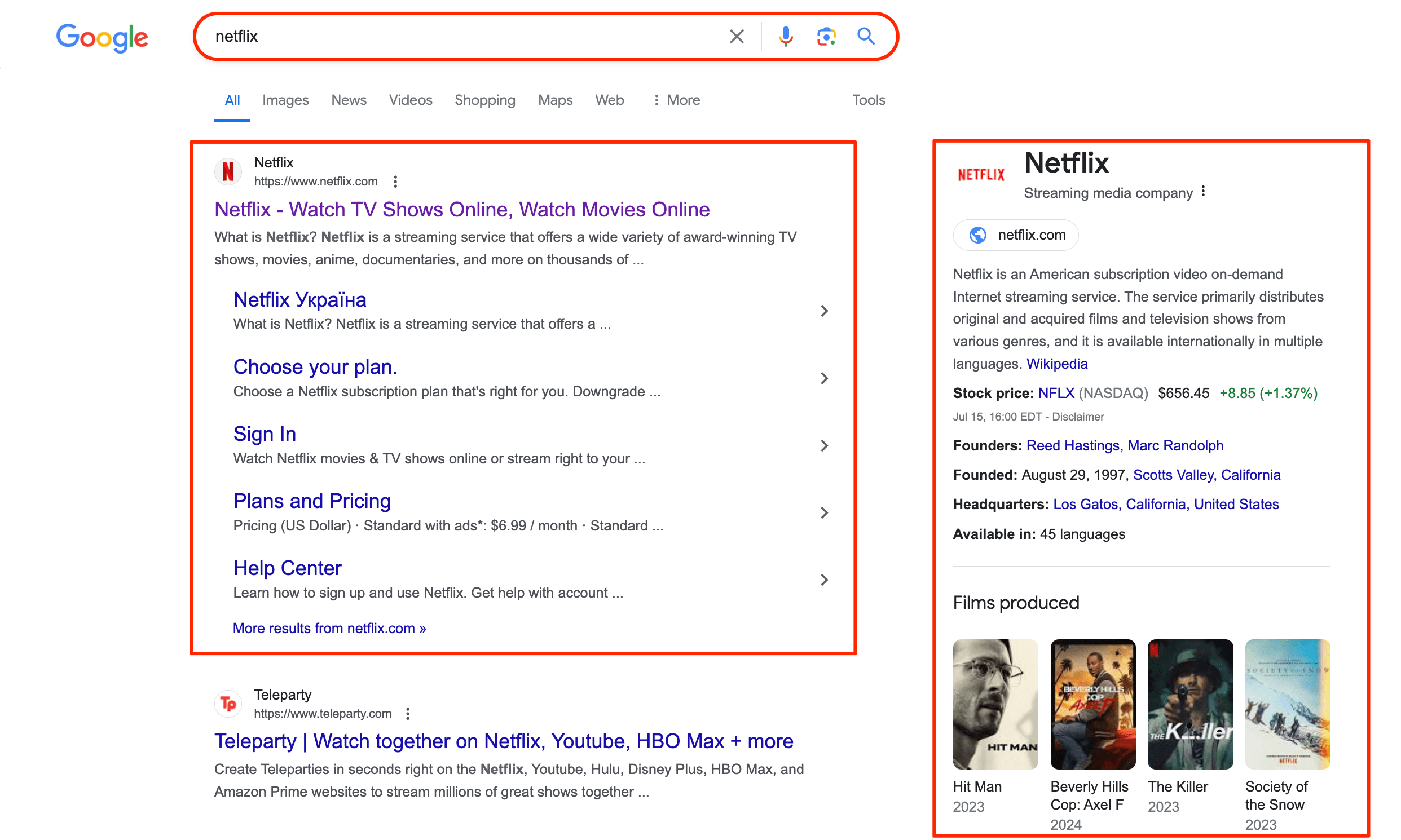
SERP Results for Transactional Intent
Transactional SERPs include paid results, shopping carousels, maps, shopping places, and reviews. Top-performing pages optimized for the transactional user intent include information about the product, its features, price, benefits, and alternatives.
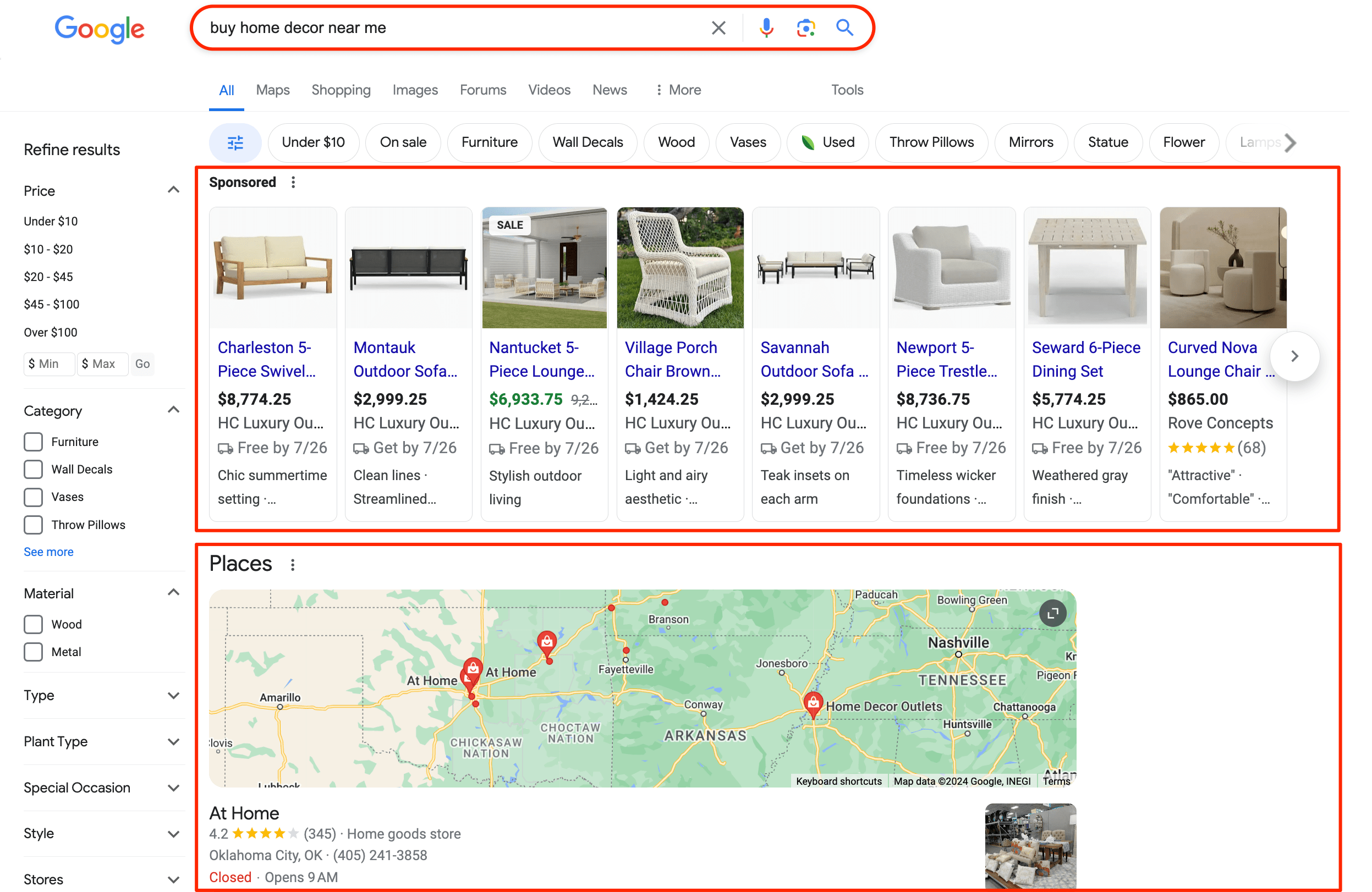
SERP Results for Commercial Intent
With commercial intent keywords, SERPs include paid results or local pack at the top. Meta titles and descriptions of top SERP players optimized for commercial user intent often include a list of different products/services accompanied by modifiers like best, top, perfect, leading, and so on.
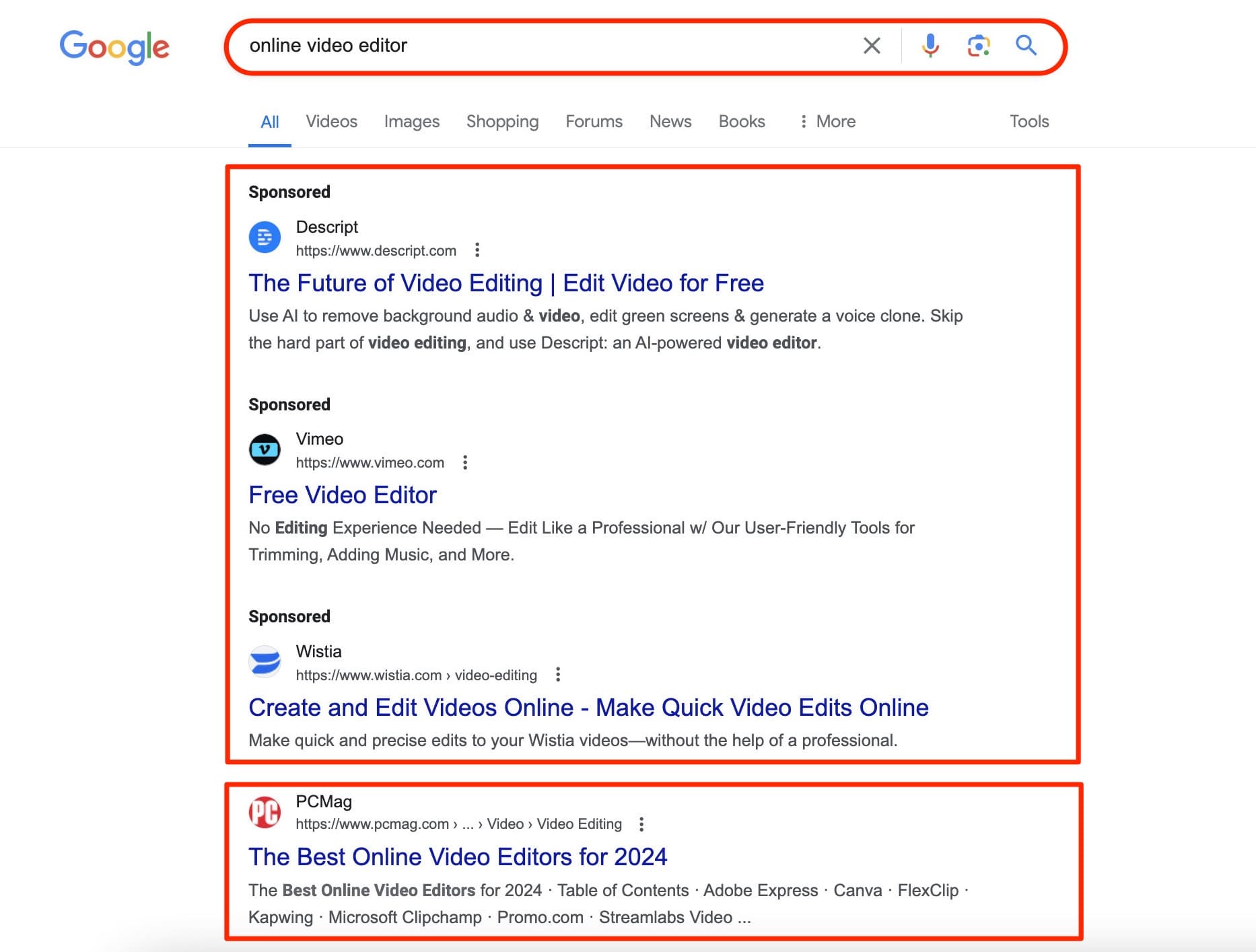
Use an Automated SEO Solution
Understanding user intent is a critical aspect of creating a successful SEO strategy, but manually analyzing search results for each keyword can be a tedious and time-consuming task. Fortunately, with the advent of automated solutions, such as SE Ranking’s Keyword Research tool, this process can be streamlined and made more efficient.
In particular, you’ll see the intent behind any keyword you enter right at the top of the screen.
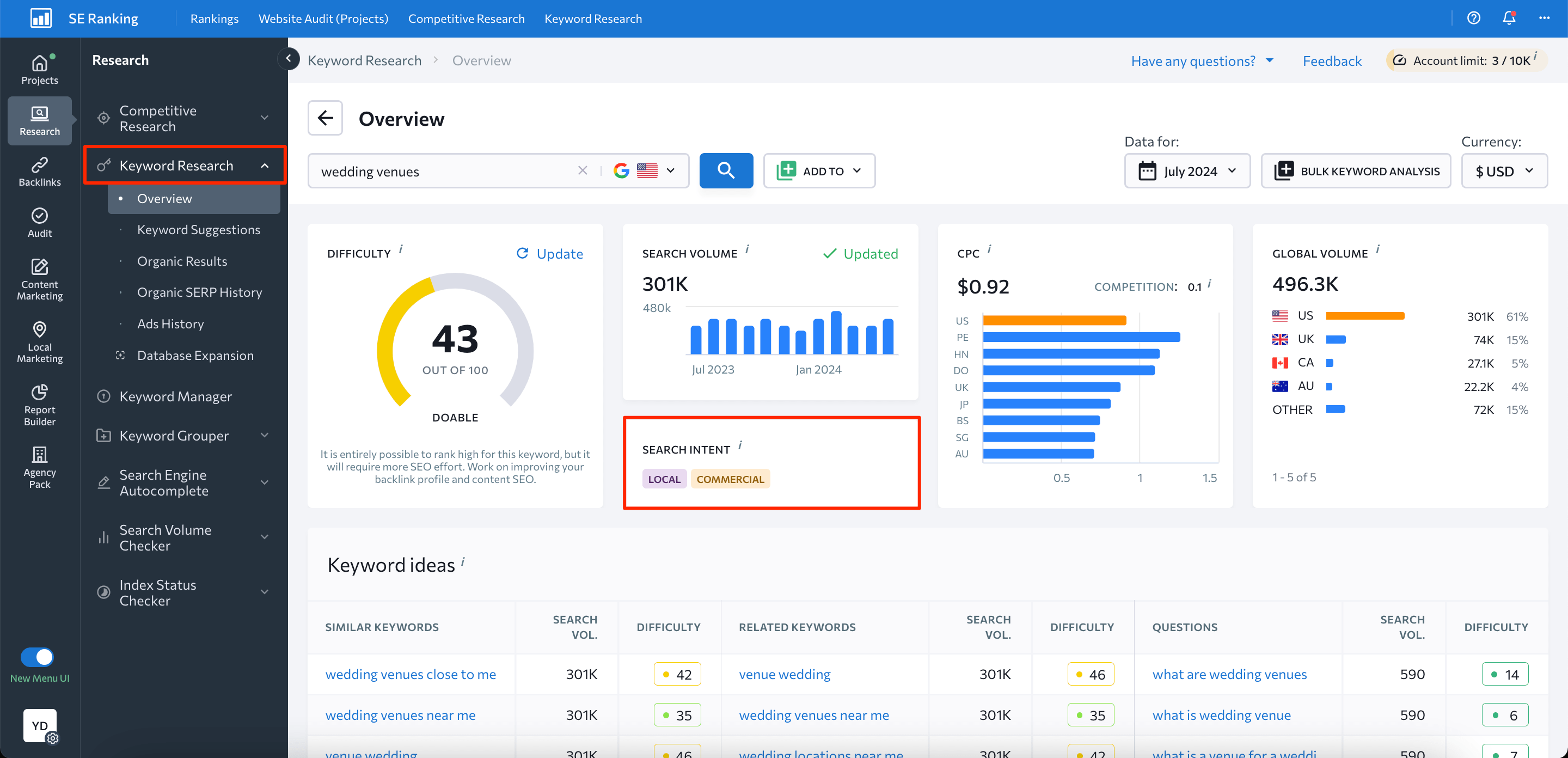
Each keyword you enter into the tool gets analyzed for search intent. This information can be used to create a list of intent-specific keywords to optimize content quickly and efficiently.
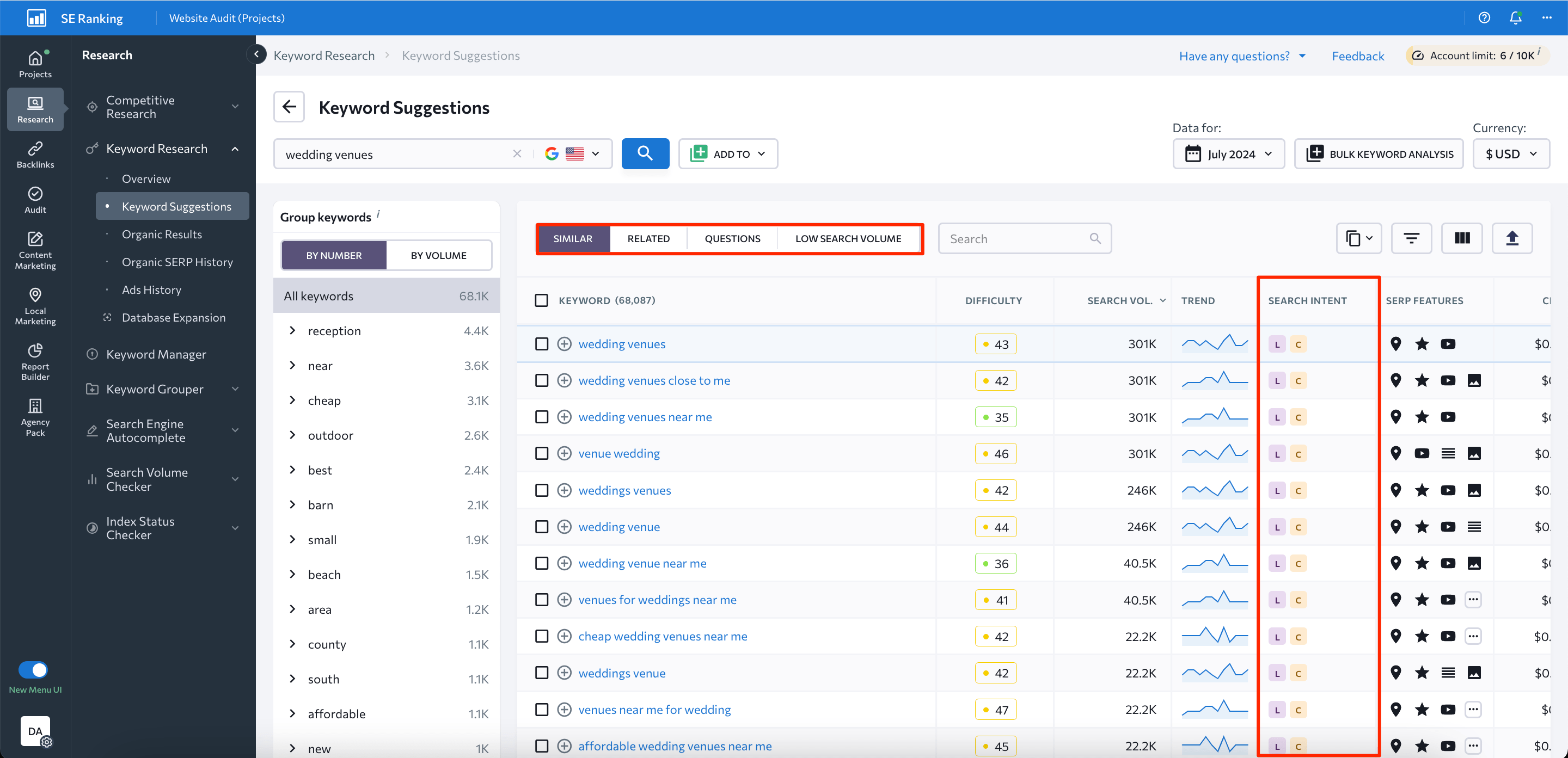
Using filters, you can quickly identify a list of keywords with any user intent you want, be it informational, navigational, commercial, transactional, or local.
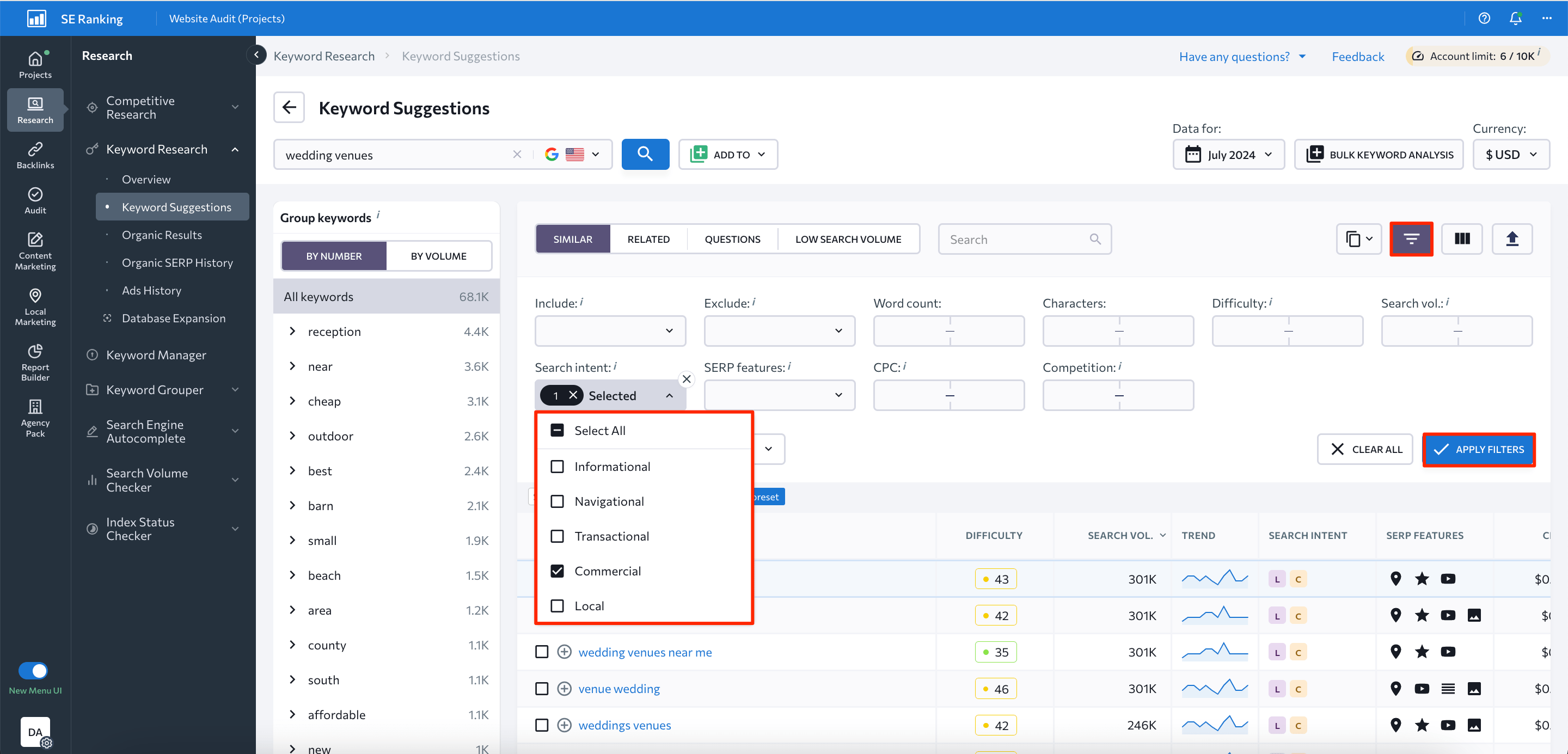
You can easily add a list of keywords with a specific search intent to a project, a Keyword Manager list, or straight to the Content Editor. Alternatively, you can export these keywords in .csv or .xls format.
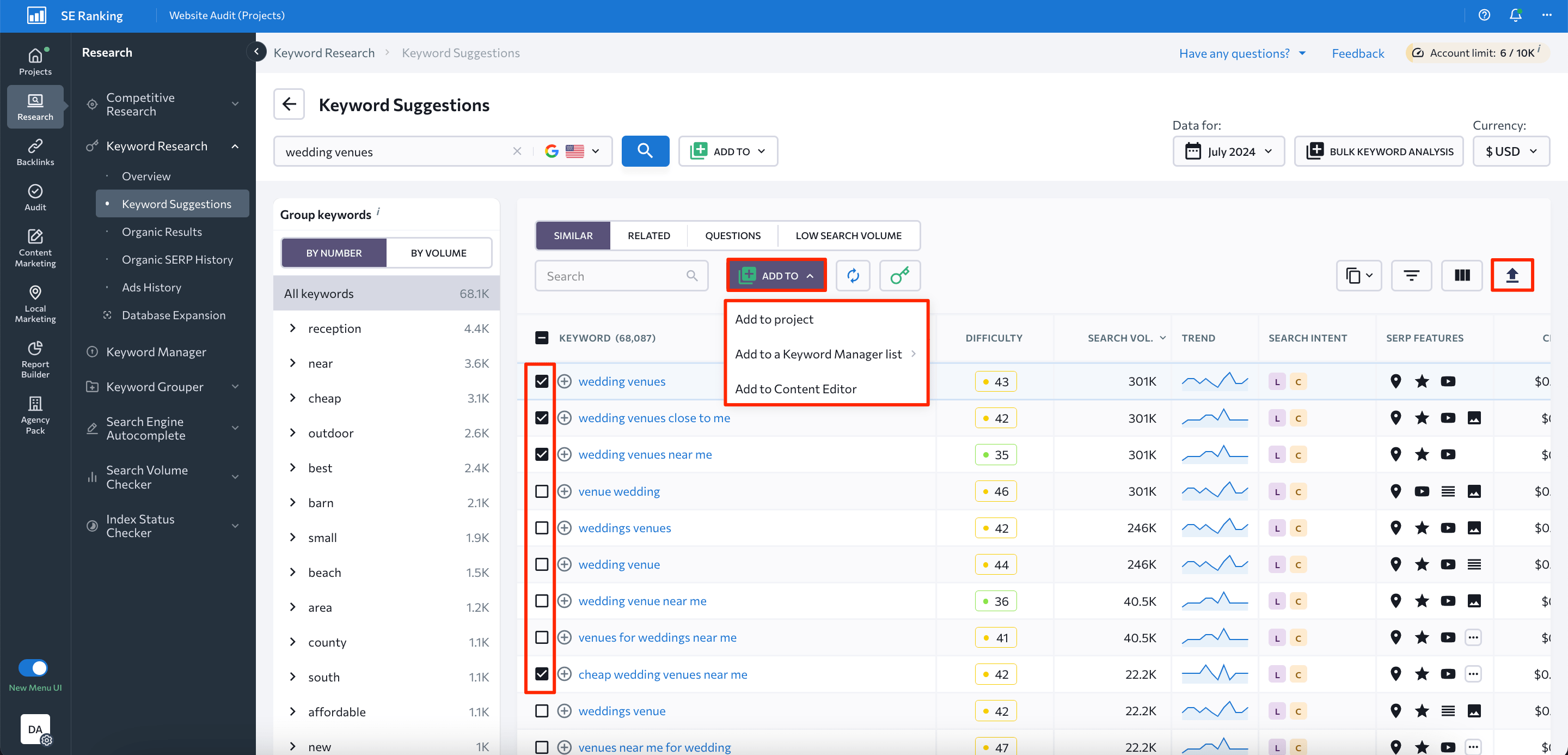
Another valuable feature of the SE Ranking platform is its Competitive Research tool. You can use this tool to figure out which keywords the target domain/URL ranks for and see what the search intent is behind them.
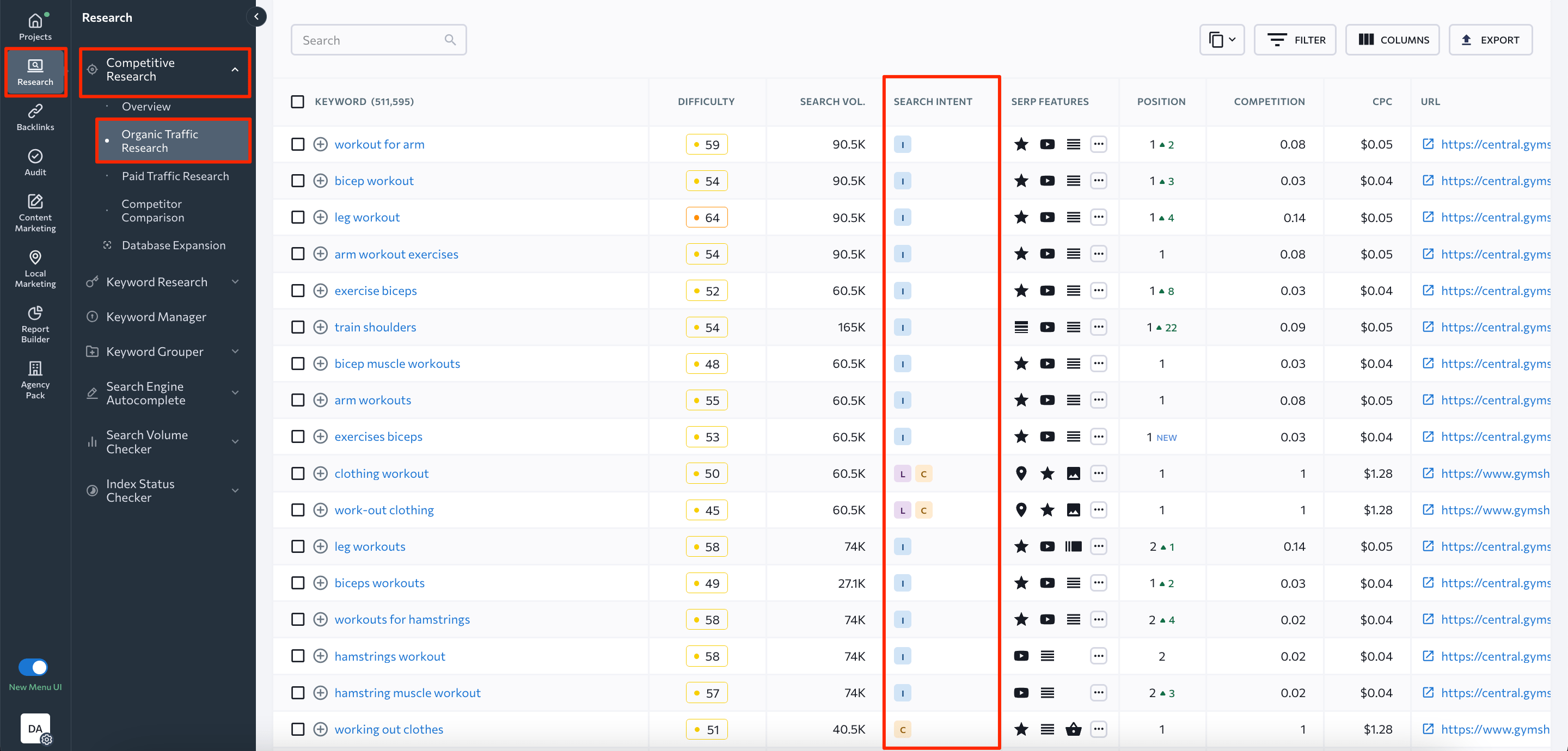
Before you move on to finding untapped keyword opportunities and carefully analyzing their search intent, make sure to check out our extensive keyword research guide that covers different methods of finding keywords, keyword grouping, and more.
Final Words
Understanding both search intent and SEO is one of the most crucial marketing tasks for ranking higher in SERPs and attracting the most motivated users. If you want your engagement and marketing strategies to pay off, write content that targets specific search intents and corresponds to the expectations of your audience. Spend more time on research so you’ll know exactly how to match your content with each keyword’s search intent.

